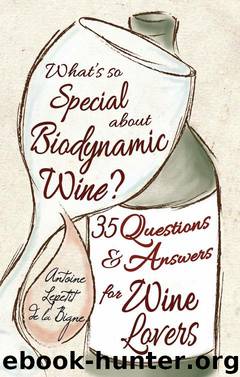What's So Special About Biodynamic Wine? by Antoine Lepetit de la Bigne

Author:Antoine Lepetit de la Bigne [Antoine Lepetit de la Bigne]
Language: eng
Format: epub
ISBN: 9781782500247
Publisher: Floris Books
Published: 2013-05-03T04:00:00+00:00
PART 3
CONSUMPTION
20. How should a biodynamic wine be tasted?
In the first two parts of this book, I have attempted to show you to what extent a biodynamic grower seeks to produce the most living wine possible. For me, living expresses the opposite of standardised. Using this hypothesis, each tasting is a unique experience, where a special connection is created between the wine taster and the wine.
In the standardised view, each wine is analysed and described in a structured way. It is the realm of the left side of the brain (see question 10: Is biodynamics scientific?). It is the view of wine-tasting experts who tell you what you should smell and detect when you taste a wine. It is the style of books that categorise wines as: ‘Meursault tastes like this, Puligny like that …’ It is the approach of wine critics who allocate rankings in the form of scores out of one hundred. It is a perspective on wine that has developed rapidly since the 1980s, primarily under Anglo-Saxon influence. Since then it has taken on much importance, but has now reached its limits. Indeed, this view can be applied naturally to standardised wines, corrected by modern oenology in order to obtain the best tasting scores (at the risk of mummifying them …), but not at all to biodynamic wines. You should be aware that standardised tasting has not always been the norm. In the Middle Ages, for example, the gourmets-experts practised a completely different style of tasting that Jacky Rigaux explores in an excellent work: La dégustation géo-sensorielle (Éditions Terres en Vues, not yet available in English).
In contrast, the living view is the right brain’s domain. It places all importance on the relationship, the unique character of the wine, the wine taster and the moment. Far from attachment to general and simplifying norms, the truth is relative, rich yet subjective, as it is based on the feelings of the taster. This point of view teaches us to taste less intellectually and to leave more room for feelings. In this regard, ‘taste and feel the wine’ is the title of a course developed in 2011 at the École du Vin et des Terroirs in Puligny-Montrachet. A few simple experiments are proposed, such as tasting blindfolded which helps to keep one’s intellect quiet. The main idea is to be more conscious of the sensations felt by the entire body, which give a much more profound perception of the wine than a simple sequential description of aromas. However, this kind of less ‘mental’ perception is also more difficult to put into words.
Ideally, of course, everyone would fully use both approaches, the right brain and the left brain. I try to do this. After my engineering studies, solidly structured by huge doses of mathematics, physics and chemistry, I also developed my feelings through tasting, manual labour and the practice of biodynamics.
How can you in practice foster the relationship between a wine and a wine taster? It can be done quite simply by putting both of them in the best possible setting.
Download
This site does not store any files on its server. We only index and link to content provided by other sites. Please contact the content providers to delete copyright contents if any and email us, we'll remove relevant links or contents immediately.
101 Whiskies to Try Before You Die by Ian Buxton(44804)
World's Best Whiskies by Dominic Roskrow(44741)
Whiskies Galore by Ian Buxton(41883)
Craft Beer for the Homebrewer by Michael Agnew(18145)
Right Here, Right Now by Georgia Beers(4128)
Not a Diet Book by James Smith(3341)
Water by Ian Miller(3129)
The Coffee Dictionary by Maxwell Colonna-Dashwood(3067)
Kitchen confidential by Anthony Bourdain(3014)
Coffee for One by KJ Fallon(2569)
Smuggler's Cove: Exotic Cocktails, Rum, and the Cult of Tiki by Martin Cate & Rebecca Cate(2473)
Superfood Smoothie Bowls: Delicious, Satisfying, Protein-Packed Blends that Boost Energy and Burn Fat by Chace Daniella(2388)
Talking as Fast as I Can by Lauren Graham(2386)
Beer is proof God loves us by Charles W. Bamforth(2375)
Bourbon: A Savor the South Cookbook by Kathleen Purvis(2246)
A Short History of Drunkenness by Forsyth Mark(2235)
Eat With Intention by Cassandra Bodzak(2157)
Cocktails for the Holidays by Editors of Imbibe magazine(2082)
Colombia Travel Guide by Lonely Planet(2066)
